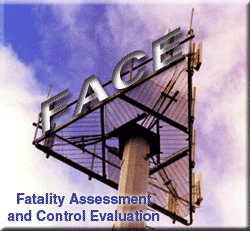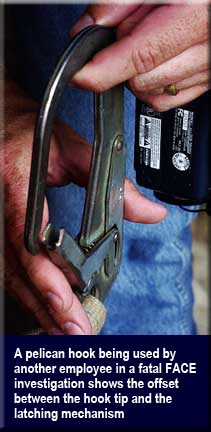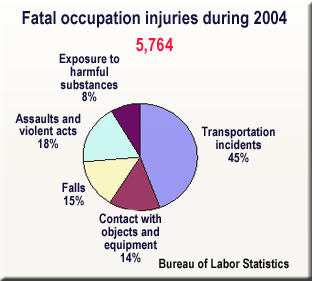|
Resurgence of interest in FACE reports rooted in rising tower climber fatality count
May 10, 2006 - Although their last tower climber fatality analysis was of a death occurring almost three years ago, the National Institute of Safety and Health's FACE reports are receiving  renewed interest by company owners and safety instructors as they strive to employ detailed fatality information to help stem this year's rising death rate of climbers. renewed interest by company owners and safety instructors as they strive to employ detailed fatality information to help stem this year's rising death rate of climbers.
NIOSH's dozen Fatality Assessment and Control Evaluation (FACE) reports provide an excellent resource for studying the decedent's work environment, the tools he was using and the role of his employer in controlling how these factors interacted.
Although the reports provide a detached analysis of an accident, the particulars can supply a disturbing narrative for people who have suffered the loss of a loved one or co-worker.
Detailed information helps to save lives
However, industry leaders and safety professionals believe that the information can be used effectively to create a greater awareness of how fatalities can easily arise and what preventative measures can be taken to keep them from occurring.
By exposing workers to the finite details of the climber's last moments in the report's summary and investigation, it is believed that tower climbers will realize that they could have been easily subjected to the same situation by not being equipped with proper fall protection equipment or not being compliant with safe working practices. The FACE reports also provide excellent recommendations and discussions.
Guest analyses welcomed
In addition to presenting an easily accessible view of the reports, Wireless Estimator has also provided an opportunity for its viewers to add their input to ensure that the wireless construction industry's professional points of view are considered by OSHA, NIOSH and other associations, companies and individuals that can assist in the communal effort to reduce climber deaths and serious injuries. 
As safety and training director of Sioux Falls Tower and Communications, Todd Thorin uses the FACE reports frequently, most recently during last week's "First Monday" monthly training of company crews where informative feedback came from company officers and tower crew members.
Todd served as the National Association of Tower Erectors' Safety & Education Chairman for the past four years, stepping down this past February. He believes that the FACE reports can complement every company's safety awareness program.
More than 500 fatality investigations involving falls in all industries have been conducted since the NIOSH In-house program was founded in 1982. In 1989 the NIOSH State-based program was established. There are currently 15 states participating.
During the past 24-years, 12 of the reports involved falls from communications structures.
Virgil Casini, the FACE program's senior investigator, has been a steadfast advocate for a safer working environment for tower construction employees. While workers were succumbing to the siren call of the profitable and enormous industry growth during the mid-1990s, Casini identified the alarming increase in climber fatalities and co-authored a NIOSH Alert to address hazards associated with telecommunication tower construction and maintenance. He has also assisted in establishing outreach programs and offering support to NATE regarding climber safety issues.
FACE off of tower fatality focus
Budgetary considerations and a new FACE focus, unfortunately, will limit the number of new investigations, if any, involving tower fatalities.
Casini said that the Morgantown, WV group of three FACE In-house inspectors' activities would be centered this year upon youth fatalities, highway and road accidents, and Hispanic worker deaths.
The latest census of fatal occupation injuries prepared by the Bureau of Labor Statistics in 2004 identified that fatal work injuries among Hispanic workers were up 11 percent after declining the previous two years. An increase in Spanish-speaking immigrants has added to the U.S. workforce and fatality rate.
The high number of injury-related deaths among Latinos may be linked to occupational hazards since a large segment of Latinos in the U.S. work in agriculture, processing plants, construction, factories, and other high-risk jobs. It has also been identified that employers may not be appropriately training workers due to language barriers and they lack bilingual materials.
During 2004 the federal Advisory Council on Occupational Safety and Health's  (ACCSH) tower task force considered the need to provide Spanish language material on tower safety. It was identified that there was a minimal Hispanic workforce and it might not be practical to move forward on extensive translations. (ACCSH) tower task force considered the need to provide Spanish language material on tower safety. It was identified that there was a minimal Hispanic workforce and it might not be practical to move forward on extensive translations.
"However, as materials become available, it would probably be a good idea to go ahead and start translating them into Spanish as well, because we'll probably see the same thing in that field as we've seen in the other fields," explained the task force's chairman, Kevin Beauregard, who envisions an increased workforce of Latinos in the wireless construction profession.
During 2004 there were 5,764 fatal occupational injuries. Deaths related to falls in all occupations - from a painter falling from a six foot ladder to a farmer falling from a tractor - totaled 864, according to the BLS. Ten of those fatalities were attributed to workers falling from a communications tower, according to OSHA's Jocko Vermillion, a Cleveland, Ohio, compliance and safety officer who identifies the number of fatalities that involve tower climbers by searching through thousands of OSHA 36 forms - a pre-inspection form used to record data pertaining to a fatality which is completed at the time the event is initially reported to the federal agency.
Based upon the approximately 8,700 for-hire-climbers in the U.S., and the ten fatalities that OSHA identified in 2004, the profession was recognized as having the highest occupational fatality rate in America. There was a marked improvement in 2005 with only seven deaths. However, during the first five months of 2006 there have already been 11 tower climber fatalities reported.
A tower technician was also killed March 10, 2006 as he exited an equipment shelter when he was struck by an antenna dropped by another contractor that was providing installation work on an adjacent tower.
|